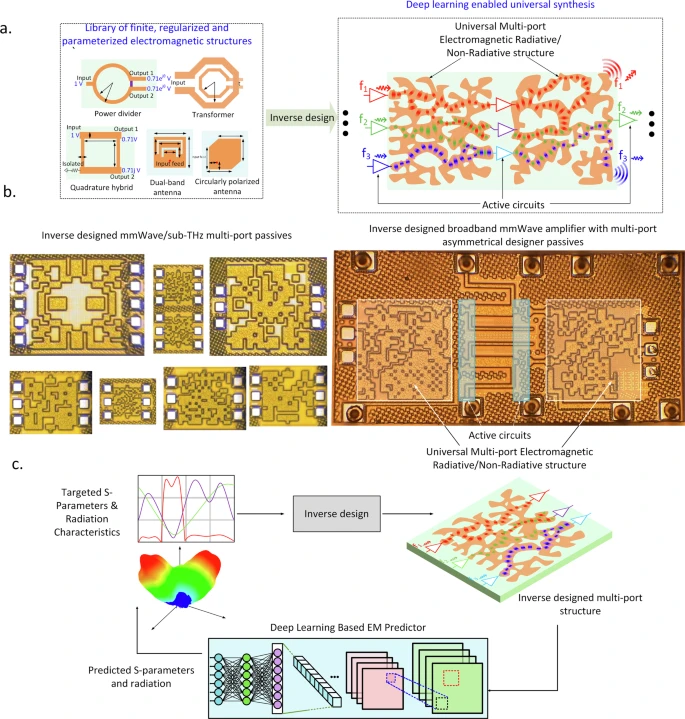Can AI create better wireless chip designs than humans?
Can AI really design wireless chips better than humans? According to a newly published study in the journal Nature Communications, the answer is yes. Better, faster, and next to impossible for humans to understand.

A close-up of a chip designed with the AI described in the study. Image credit: Princeton University.
According to a report by Princeton Engineering, “Specialized microchips that manage signals at the cutting edge of wireless technology are astounding works of miniaturization and engineering. They’re also difficult and expensive to design.” These microchips were the focus of the study. The new technique enables the rapid synthesis of complex architectures in minutes, unlike traditional algorithms that take weeks. The study even found that sometimes, this innovative method generates structures that are otherwise impossible to create with existing approaches.
“Classical designs, carefully, put these circuits and electromagnetic elements together, piece by piece, so that the signal flows in the way we want it to flow in the chip. By changing those structures, we incorporate new properties,” Professor Kaushik Sengupta, lead researcher and co-director of NextG, Princeton’s industry partnership program for next-generation communications, said. “Before, we had a finite way of doing this, but now the options are much larger.”
Deep learning
Researchers from Princeton University and the Indian Institute of Technology Madras employed deep learning-based models using an inverse design approach with arbitrary-shaped electromagnetic structures such as antennas, filters, splitters, and switches. The result was transformative: within minutes, the AI produced designs with novel structures.
A deep convolutional neural network (CNN) was used as an electromagnetic (EM) emulator. The input is the arbitrary geometry with arbitrary port placements, and the output is the predicted multi-port scattering and radiative properties.

a) The proposed approach for chip synthesis with inverse-designed arbitrary-shaped multi-port radiative and non-radiative structures co-designed with circuits. b) Inverse-designed integrated multi-port millimeter-wave passive structures and end-to-end mm-Wave amplifier circuit chip with co-design between multi-port passive and active circuitry. The chips are fabricated in industry standard 90-nm BiCMOS foundry. c) Inverse synthesis of arbitrary multi-port electromagnetic structures with desired scattering and radiating properties, enabled through a deep-learning based forward electromagnetic emulator. The latter takes the image of the structure and predicts accurately its multi-port scattering and radiating properties across frequencies in the space of arbitrary-shaped planar structures. Image credit: Nature.
RF Toolbox and Antenna Toolbox were used extensively to design and simulate the electromagnetic properties of the structures and circuits. These simulations generated datasets used to train the deep neural network model to predict the electromagnetic properties of the designs. Parallel Computing Toolbox accelerated these RF and EM simulations, with workloads offloaded to the HPC cluster at the university.
The CNN was developed with Deep Learning Toolbox. Deep Learning Toolbox was used to design and train the deep neural networks to predict scattering and radiative properties of the arbitrarily shaped electromagnetic structures. Deep Learning Toolbox was also used with Parallel Computing Toolbox for training and inference on the university’s local GPUs.
In the study, the researchers state, “Once trained, the synthesis achieves the target specifications within minutes.
AI thinks differently from humans
Chip designers often spend years perfecting their craft. The thought process is typically linear, based on pre-selected templates of EM structure. The resulting topologies are often handcrafted layouts based on extensive training and experience. The AI doesn’t think in the same linear manner, instead developing arbitrarily shaped based on the desired EM characteristics and functionality.
“We are coming up with structures that are complex and look random shaped, and when connected with circuits, they create previously unachievable performance. Humans cannot really understand them, but they can work better,” said Sengupta.
Uday Khankhoje, a co-author and associate professor of electrical engineering at Indian Institute of Technology Madras, said the new technique not only delivers efficiency but promises to unlock new approaches to design challenges that have been beyond the capability of engineers.
“This work presents a compelling vision of the future,” he said. “AI powers not just the acceleration of time-consuming electromagnetic simulations, but also enables exploration into a hitherto unexplored design space and delivers stunning high-performance devices that run counter to the usual rules of thumb and human intuition.”

An enlarged image of the chip’s circuitry in Sengupta’s lab at Princeton, with Professor Kaushik Sengupta, left, and first author Emir Ali Karahan, a graduate student in electrical and computer engineering. Image credit: Princeton University.
The increasing complexity and demands of next-generation wireless systems necessitates new design paradigms for RF and EM structures. The research presented opens new avenues in this direction and will help designers meet stringent requirements on the size and performance of these devices.
According to Popular Mechanics, “The right algorithm, they say, could suggest new paradigms in a matter of minutes. From there, engineers could use these paradigms as innovative starting points for their own ideas.”
Removing the need for human designers?
Will this AI remove the need for human designers? Not likely, according to the researchers. The goal is to enhance designs with those that have not yet been considered. Still, human oversight is needed to ensure that the AI doesn’t create faulty or inefficient arrangements, and to avoid AI hallucinations that could introduce elements that don’t work at all.
“There are pitfalls that still require human designers to correct,” Sengupta said. “The point is not to replace human designers with tools. The point is to enhance productivity with new tools. The human mind is best utilized to create or invent new things, and the more mundane, utilitarian work can be offloaded to these tools.”
To read the full research paper, see DOI 10.1038/s41467-024-54178-1.








评论
要发表评论,请点击 此处 登录到您的 MathWorks 帐户或创建一个新帐户。